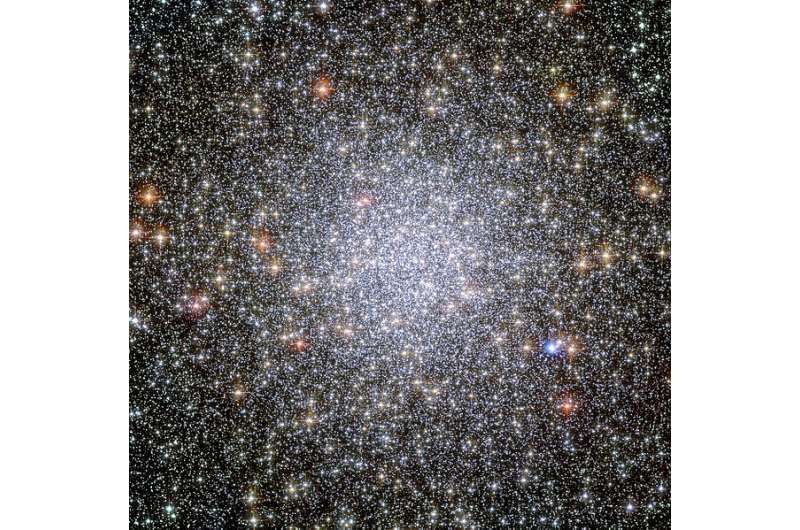May 30, 2017 report
Astronomers detect 22 new cataclysmic variables in globular cluster 47 Tucanae

(Phys.org)—An international team of astronomers led by Liliana Rivera Sandoval of the University of Amsterdam, Netherlands, has found 22 new cataclysmic variable stars in a globular cluster known as 47 Tucanae (47 Tuc for short). The discovery makes 47 Tuc the cluster with the highest number of cataclysmic variables identified so far. The findings were detailed in a paper published May 19 on arXiv.org.
Cataclysmic variables (CVs) are binary star systems consisting of a white dwarf and a normal star companion. They irregularly increase in brightness by a large factor, then drop back down to a quiescent state. These binaries have been found in different environments such as the center of the Milky Way galaxy, the solar neighborhood, and within open and globular clusters. Studying CVs in globular clusters is important for understanding how they affect the evolution of such groups of stars and to gain insights into how stellar interactions in a dense stellar environment affect the evolution of cataclysmic variables.
Located approximately 15,300 light years away from the Earth, 47 Tuc is a massive, non core-collapsed globular cluster in the constellation Tucana. This cluster shows low extinction, has a high interaction rate and has the most X-ray sources identified so far among any other globular clusters. These properties make 47 Tuc an excellent target to study close binaries, what can potentially lead to detection of many cataclysmic variables.
That is why Sandoval and her team have analyzed the available near-ultraviolet and optical images from the Hubble Space Telescope, in combination with X-ray data from NASA's Chandra X-ray Observatory, which resulted in finding new CVs in 47 Tuc. The research increased the number of known cataclysmic variables in this cluster from 21 to 43.
"In this paper, we identify the largest number of CVs ever identified in a globular cluster through X-ray counterpart identification, more than doubling the number of known CVs in 47 Tuc," the astronomers wrote in the paper.
According to the study, CVs in 47 Tuc are more concentrated towards the cluster center than the main sequence turnoff stars. All the cataclysmic variables in this cluster have a blue color in the near-ultraviolet and in the optical color magnitude diagrams. This is due to emission from the accretor (white dwarf) and the accretion disk.
The researchers revealed that eighteen CVs in the cluster showcase hydrogen-alpha emission, which is likely coming from the accretion disk or stream and contributions from the companion star. Moreover, four cataclysmic variables were found to have large amplitude variations (up to about 3 magnitudes) in time-scales of hours. However, the cause of these variations remains unexplained.
Given the fact that 47 Tuc is a non core-collapsed cluster, the team tried to compared its CV population to those of NGC 6397 and NGC 6752 – two examples of core-collapsed clusters.
"47 Tuc has many more faint CVs than those core-collapsed clusters. This suggests that the CV population in 47 Tuc is a combination of primordial CVs and dynamically CVs formed a long time ago. (...) If we scale the masses of NGC 6397 and NGC 6752 to that of 47 Tuc, the core-collapsed clusters have many more bright CVs. This seems to indicate that the dynamical interactions play a major role in core-collapsed clusters to create CVs," the researchers concluded.
More information: New Cataclysmic Variables and other Exotic Binaries in the Globular Cluster 47 Tucanae, arXiv:1705.07100 [astro-ph.SR] arxiv.org/abs/1705.07100
Abstract
We present 22 new (+3 confirmed) cataclysmic variables (CVs) in the non core-collapsed globular cluster 47 Tucanae (47 Tuc). The total number of CVs in the cluster is now 43, the largest sample in any globular cluster so far. For the identifications we used near-ultraviolet (NUV) and optical images from the Hubble Space Telescope, in combination with X-ray results from the Chandra X-ray Observatory. This allowed us to build the deepest NUV CV luminosity function of the cluster. We found that the CVs in 47 Tuc are more concentrated towards the cluster center than the main sequence turnoff stars. We compared our results to the CV populations of the core-collapsed globular clusters NGC 6397 and NGC 6752. We found that 47 Tuc has fewer bright CVs per unit mass than those two other clusters. That suggests that dynamical interactions in core-collapsed clusters play a major role creating new CVs. In 47 Tuc, the CV population is probably dominated by primordial and old dynamically formed systems. We estimated that the CVs in 47 Tuc have total masses of approx. 1.4 M_sun. We also found that the X-ray luminosity function of the CVs in the three clusters is bimodal. Additionally, we discuss a possible double degenerate system and an intriguing/unclassified object. Finally, we present four systems that could be millisecond pulsar companions given their X-ray and NUV/optical colors. For one of them we present very strong evidence for being an ablated companion. The other three could be CO- or He-WDs.
© 2017 Phys.org





















